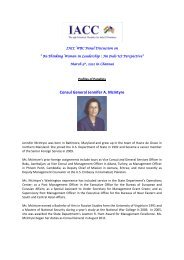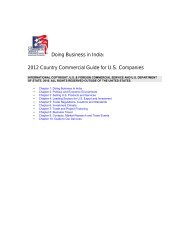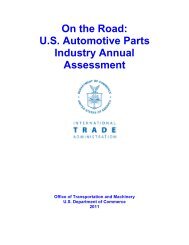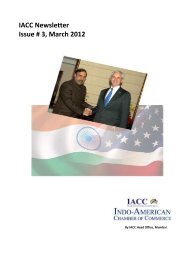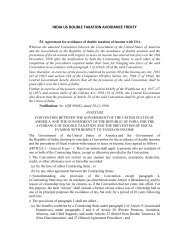Download the PDF version here - Indo-American Chamber Of ...
Download the PDF version here - Indo-American Chamber Of ...
Download the PDF version here - Indo-American Chamber Of ...
You also want an ePaper? Increase the reach of your titles
YUMPU automatically turns print PDFs into web optimized ePapers that Google loves.
How does India fare in <strong>the</strong> Asian region?<br />
GE Healthcare operates in seven regions - US, Europe, Latin America, India, China, Asia-Pacific, and<br />
Middle-east and Africa. India is identified as a key region for growth. India contributes 20% of overall<br />
Asia revenues. Though India's revenue contribution to overall GE Healthcare is small, it is improving and<br />
we are targeting to reach $1 billion over <strong>the</strong> next couple of years. In addition to that, <strong>the</strong> capability that<br />
we have <strong>here</strong> is extremely important. We have 4,000 engineers in Bangalore working on product<br />
development - <strong>the</strong>ir product development is not just for <strong>the</strong> Indian market, but important for our global<br />
supply chain. We also do quite a bit of manufacturing in India for several of our product lines.<br />
GE recently moved its X-ray business to China. How does <strong>the</strong> company view India and its capabilities?<br />
Both China and India have tremendous engineering capabilities, and are growing at high rates. The<br />
comparison ends <strong>the</strong>re. China is a bit more mature in <strong>the</strong> sense of as it is a bigger market than India.<br />
Healthcare purchases are done heavily by <strong>the</strong> government. Like western countries, <strong>the</strong>re is<br />
reimbursement and insurance penetration is better. However, India is very different. Insurance<br />
penetration is very low and <strong>the</strong>re is no government reimbursement. Healthcare is driven largely out of<br />
pocket and offers a very interesting dynamic - consumerism.<br />
We have plenty of investments in both <strong>the</strong> countries. GE Healthcare spends an average of $50 million<br />
every year on R&D for healthcare solutions in India. We have large R&D centres in both countries, <strong>the</strong><br />
one in India being <strong>the</strong> largest in <strong>the</strong> world with about 4,000 people and 1,200 people focusing only on<br />
healthcare solutions. China, India and Europe are now handling roughly one-third of all development<br />
work outside <strong>the</strong> US now.<br />
Click <strong>here</strong> for index<br />
Siraj A. Chaudhry | Cargill India eyes bigger bite of food business<br />
“We do have <strong>the</strong> potential to bring in a lot of products, to create products, to help our customers create<br />
products which are going to be <strong>the</strong> need of <strong>the</strong> consumer”<br />
Food for thought: Chaudhry says building food brands in India is not easy as tastes and preferences vary across<br />
geographies<br />
A supplier to top biscuit and instant noodles makers and fast food chains, <strong>the</strong> company is eyeing an even<br />
bigger growth with a combination of organic and inorganic means, sighting ample opportunity in India’s<br />
$330 billion food market, which is expected to more than triple by 2020.<br />
Siraj A. Chaudhry, chairman of Cargill India, said in an interview that <strong>the</strong> company has identified food<br />
ingredients and staples as its focus, and that it may launch more products in <strong>the</strong> years ahead armed with<br />
its learning on <strong>the</strong> complex and fragmented Indian markets.








